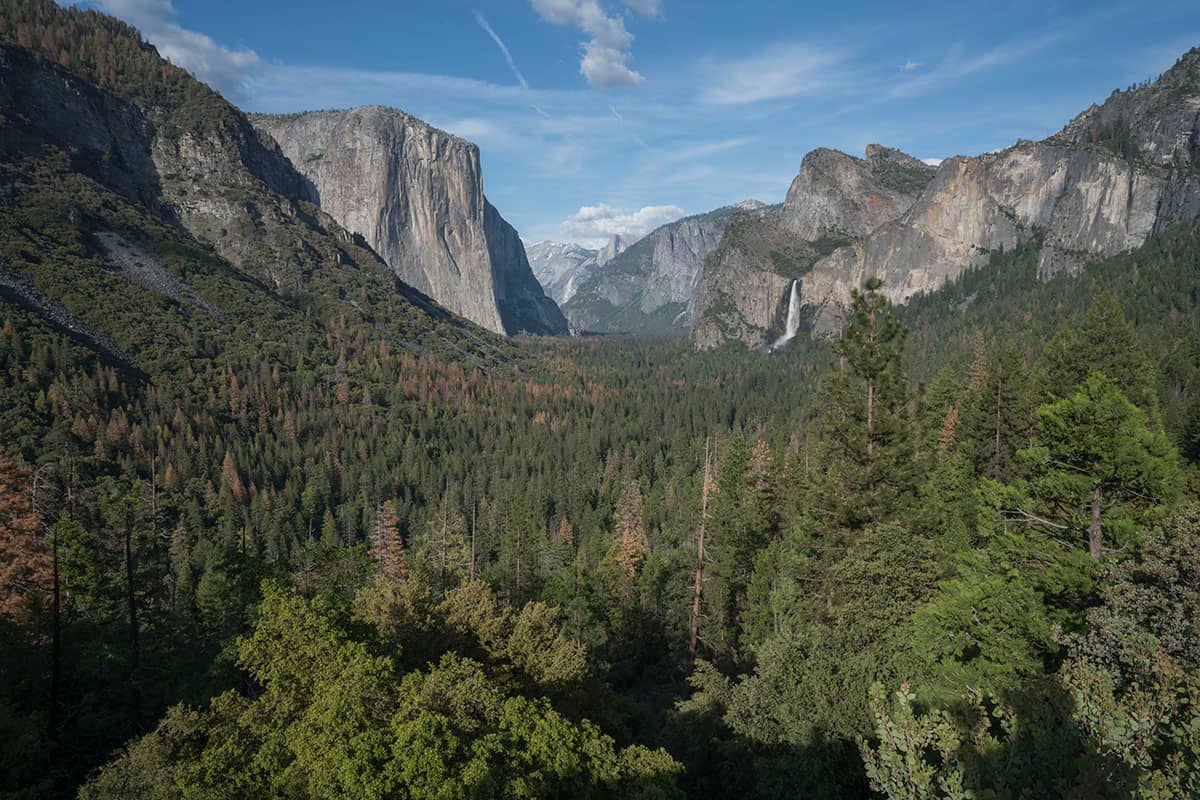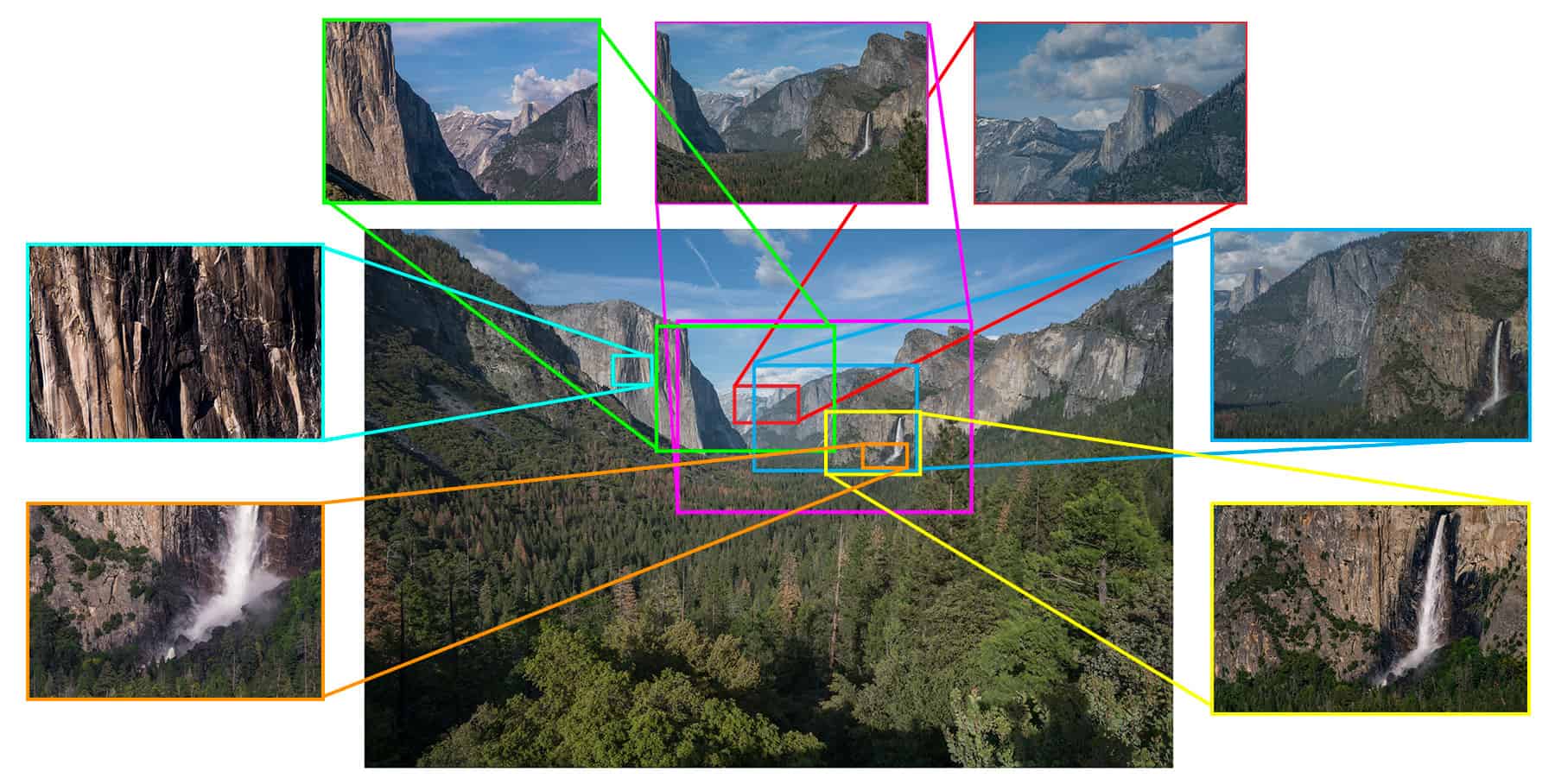Is there a right lens for every scene?
Every once in a while, I get this question on a workshop, “Blake what is the right lens for this scene?” I usually look at what the person is shooting and make my judgment based on the time of day, the subject matter and sometimes the speed of the lens. Those are all great ideas for choosing the right lens, but what if you want to capture the personalities of the scene? Is there ever a right lens for that?
When we were in Yosemite, we stopped at Tunnel View several times. The first few times we stopped I shot it with my “go-to” 16-35mm lens. As many of you know, I call myself the “Wide Angle Junkie” because I tend to weight pretty heavily for wide angle lenses. However, I got quite bored shooting Tunnel View repeatedly at 16mm.

As I was shooting a longer exposure than normal, I noticed all the little intricacies of the scene while my exposure was being recorded. I decided to switch on a 50mm to see if I could get a more tight crop on some of the features of the Valley. After seeing things tighter with the 50mm, I went to my telephoto zoom and started to navigate the scene at 70 mm, then 125mm, then 200, then 300. I even went so far as to put my a7rII in forced Crop sensor mode to get 450mm of reach.
Needless to say, I got addicted. I started to think about the different personalities of Tunnel View that are not prominent at 16mm. What I noticed about our week there was that as I started to learn the names of the different places in the Valley, El Capitan, Sentinel Dome, Half Dome, Bridal Veil Falls, the Three Brothers, I started to notice them more. I noticed how light would hit them at different times of the day, and I began to look for them at every stop in the valley to see what angle would portray their personalities the best.
I know, I am talking about granite structures as if they are people, but if you want to be a successful landscape photographer you almost have to! It is possible to capture the personality of a scene with your camera; you just have to know where and how to look for it.

Is there a right lens for every scene?
Not necessarily, but each lens will allow you to see the landscape’s personalities differently. This weekend, go out with three lenses, your widest, your mid range, and your telephoto zoom. It doesn’t have to be the best telephoto zoom, heck I use the Canon 70-300 f4 – 5.6 (that I bought on rebate for $170 with my 6D with a Metabones adapter on my Sony). It is a Frankenstein setup, to say the least, but it works. Now do the following:
- Go out, walk around your scene for 45 minutes without taking a picture. Notice how the light hits certain areas and find a place that speaks to you the most.
- Put your wide on and shoot to document the scene.
- Then put the 50 on and get a tighter crop of the subject. As you navigate with your 50, think about the areas you want to pinpoint with your telephoto.
- Take your telephoto to 70, then 120, then 150, then 200, then 300. Go deeper and build compositions that show the personalities of every aspect of the scene.
There is no right lens except for the lens you have with you. Go out, make the best you can with what you have, but think about how to capture the personality of the scene. You will find that the lens is less important than the personality you are capturing.









If I have to go out with one lens, it’s my 40-150/2.8 which on my 2x crop sensor bodies is like 80-300 in 35mm film speak. I can often times stitch some together to get a wider look but it’s less fun to crop dramatically in a very wide shot to replicate a telephoto. On 1.5x crop sensor bodies, I’d probably use a 50-150 range most. When I carried around full frame sensor bodies, I preferred the 70-200 for 75% of what I did in the landscape. One reason I like those telephoto zooms is they often focus down very close, giving you faux macro capabilities as well. My 40-150/2.8 focuses to 20″. With a 1.4x teleconverter, it’s a 1:2 macro, which isn’t bad. When I’m usually out with two bodies, the other one has a 12-40/2.8 or 7-14/2.8 and it’s usually, not always, but usually, doing a time lapse because when I’m ready to edit the time lapse, I can crop to 4k or HD within the frame and move the viewer through the scene in powerful ways.
My goto lens on my Nikon is an 18-200mm. For landscapes, I use it at different focal lengths on my Nikon D300s, cropped sensor camera. It allows me to get wide views and telephoto views, with lots in between. This rig, along with an electronic cable release, sits on a lightweight tripod that holds it securely except in very high winds. By using the sweet spot on this lens, that actually ranges from f8 to f16, and no wider than 24mm (to avoid distortion), my images look good.
I’ve always loved looking at things with my “big” lens because you can often find very interesting compositions you wouldn’t have noticed without it. I had a great time photographing a harbor and its various reflections from a distance with my big lens. I like the unexpected.
You have just proven the utility of zoom lenses and the reason for their huge popularity. Standing in one place with the ability to change the perspective and content of an image is fabulous.
I do have a Sigma 70-300 that I use on my 70D, I use this for landscape, and I also use my Canon 17-85. I guess it is what I am wanting to express in my photo. Every day I try to learn something new from my photo’s.
Unless there is something magical about your Sony, putting it into crop mode gained you absolutely nothing. Not more zoom, not more magnification. And certainly not 450mm of reach. The only thing you got was a smaller file. There is no value in crop mode when you can crop in post and get exactly the same resulting image. That choice affects the geometry of the shot not one iota when you don’t actually change anything that matters.
Bringing it up here seems a disservice to your readers.
You may have a point. However, the practice here was to get in as far as I could on the scene and one way to get in closer was to crop in camera. I was not worried about technical aspects of the Raw File, just a further reach into the scene. I know me pretty well and I know I wouldn’t crop in more than 50% after the fact. This was a practice in making a composition with the equivalent of 450mm in reach.
Ah, but there is something magical in the A7rII …… In crop mode you are still capturing, I believe, an 18 megapixel image which is more than enough to make a great large print …… so why not use the extra reach to get in closer and frame “in camera” while you are at the location and still fully immersed in the scene.
A great heads-up! I fortunately live in a scenic environment but have fallen into the habit of shooting the same lovely scenes in the same old way. Blake has given me a new approach. I can also tend to “not want to leave anything out” which is counterproductive.
Blake…
Let’s have a discussion about wide angle lenses for the Sony alpha series. Yes, there is the advantages of a 70-200mm or other zoom.
What prime or wide angle zooms top the list?
Where does one turn for accurate, constant reviews? DXO Mark, while highly referred to, offers very little information. On the other hand, DPReview provides details & member feedback on numerous product reviews.
Here is an example of what to believe from a recognized pro blogger:
“The Voigtlander 15 is one of my all time fave lenses just for the fun factor and low-cost of $600.”
Later in a more recent blog he states: “I have used the manual Voigtlander 15mm f/4.5 on many occasions over the past 4-5 years but on most of the Sony full frame bodies (A7, A7r, A7II) it suffers from color issues and massive vignetting.”
In the end, I’m requesting your input for those of us that are not proficient/experienced in how to go about evaluating a possible new lens.
Thanks!
Rick in Spokane
I have found that there is no review that I can read that is going to be as good as having it in my hands. Personal experience is subjective. All I really need in my kit is the 16-35mm Zeiss Wide Angle lens and the Rokinon 14mm. I think you may be looking too far into it. Try renting any glass you may be interested in first and go from there.